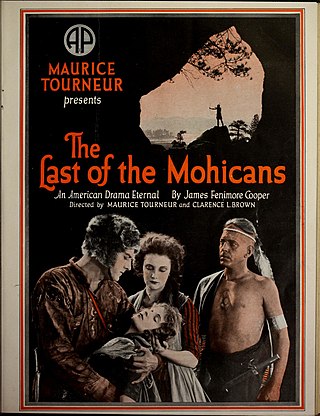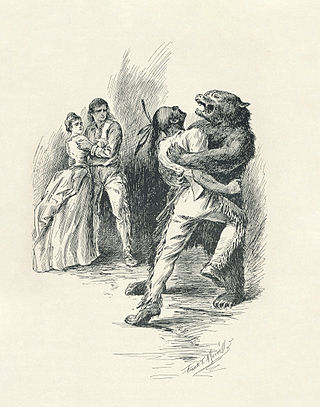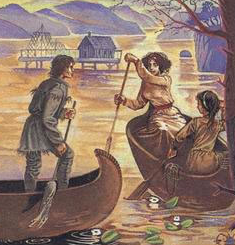
The Last of the Mohicans is a 1920 American silent adventure drama film written by Robert A. Dillon, adapted from James Fenimore Cooper's 1826 novel of the same name. Clarence Brown and Maurice Tourneur co-directed the film. It is a story of two English sisters meeting danger on the frontier of the American colonies, in and around the fort commanded by their father. The adventure film stars Wallace Beery, Barbara Bedford, Lillian Hall, Alan Roscoe and Boris Karloff in one of his earliest silent film roles. Barbara Bedford later married her co-star in the film, Alan Roscoe in real life. The production was shot near Big Bear Lake and in Yosemite Valley.

James Fenimore Cooper was an American writer of the first half of the 19th century, whose historical romances depicting colonial and indigenous characters from the 17th to the 19th centuries brought him fame and fortune. He lived much of his boyhood and the last fifteen years of life in Cooperstown, New York, which was founded by his father William Cooper on property that he owned. Cooper became a member of the Episcopal Church shortly before his death and contributed generously to it. He attended Yale University for three years, where he was a member of the Linonian Society.

The Last of the Mohicans: A Narrative of 1757 is an historical romance novel written by James Fenimore Cooper in 1826.

The Leatherstocking Tales is a series of five novels by American writer James Fenimore Cooper, set in the eighteenth-century era of development in the primarily former Iroquois areas in central New York. Each novel features Natty Bumppo, a frontiersman known to European-American settlers as "Leatherstocking", "The Pathfinder", and "the trapper". Native Americans call him "Deerslayer", "La Longue Carabine", and "Hawkeye".

Chingachgook is a fictional character in four of James Fenimore Cooper's five Leatherstocking Tales, including his 1826 novel The Last of the Mohicans. Chingachgook was a lone Mohican chief and companion of the series' hero, Natty Bumppo. In The Deerslayer, Chingachgook married Wah-ta-Wah, who bore him a son named Uncas, but died while she was still young. Uncas, who was at his birth "last of the Mohicans", grew to manhood but was killed in a battle with the Huron warrior Magua. Chingachgook died as an old man in the novel The Pioneers, which makes him the actual "last of the Mohicans," having outlived his son.
David Shipman is generally considered to be the real-life inspiration for James Fenimore Cooper's character Natty Bumppo in the Leatherstocking Tales along with a pioneer man named Thomas Leffingwell, a co-founder of Norwich, CT, whose son founded the Leffingwell Inn, now a museum. When Cooper's father Judge William Cooper settled in what is now Otsego County, New York in the mid-1780s, Shipman lived alone in a small cabin in the hills south of the village of Cooperstown, a squatter on the land of Cooper's neighbor John Christopher Hartwick.

The capture and rescue of Jemima Boone and the Callaway girls is a famous incident in the colonial history of Kentucky. Three girls were captured by a Cherokee-Shawnee raiding party on July 14, 1776 and rescued three days later by Daniel Boone and his party, celebrated for their success. The incident was portrayed in 19th-century literature and paintings: James Fenimore Cooper created a fictionalized version of the episode in his novel The Last of the Mohicans (1826) and Charles Ferdinand Wimar painted The Abduction of Boone's Daughter by the Indians.

The Deerslayer, or The First War-Path (1841) was James Fenimore Cooper's last novel in his Leatherstocking Tales. Its 1740–1745 time period makes it the first installment chronologically and in the lifetime of the hero of the Leatherstocking tales, Natty Bumppo. The novel's setting on Otsego Lake in central, upstate New York, is the same as that of The Pioneers, the first of the Leatherstocking Tales to be published (1823). The Deerslayer is considered to be the prequel to the rest of the series. Fenimore Cooper begins his work by relating the astonishing advance of civilization in New York State, which is the setting of four of his five Leatherstocking Tales.

The Last of the Mohicans is a 1932 American pre-Code Mascot movie serial based on the 1826 novel The Last of the Mohicans by James Fenimore Cooper.

The Pathfinder, or The Inland Sea is a historical novel by American author James Fenimore Cooper, first published in 1840. It is the fourth novel Cooper wrote featuring Natty Bumppo, his fictitious frontier hero, and the third chronological episode of the Leatherstocking Tales. The inland sea of the title is Lake Ontario.

The Prairie: A Tale (1827) is a novel by James Fenimore Cooper, the third novel written by him featuring Natty Bumppo. His fictitious frontier hero Bumppo is never called by his name, but is instead referred to as "the trapper" or "the old man." Chronologically The Prairie is the fifth and final installment of the Leatherstocking Tales, though it was published before The Pathfinder (1840) and The Deerslayer (1841). It depicts Natty in the final year of his life, still proving helpful to people in distress on the American frontier. The book frequently references characters and events from the two books previously published in the Leatherstocking Tales as well as the two which Cooper wouldn't write for more than ten years. Continuity with The Last of the Mohicans is indicated by the appearance of the grandson of Duncan and Alice Heyward, as well as the noble Pawnee chief Hard Heart, whose name is English for the French nickname for the Delaware, le Coeur-dur.

Nathaniel "Natty" Bumppo is a fictional character and the protagonist of James Fenimore Cooper's pentalogy of novels known as the Leatherstocking Tales.

Hawkeye is a television series, airing in syndication for one season during 1994–1995, and produced by Stephen J. Cannell. The series was filmed in North Vancouver and Vancouver, British Columbia, Canada.

The Monsters of Templeton is a dramatic novel written by Lauren Groff. Groff was born and raised in Cooperstown, New York. The name Templeton draws from the name devised for the town by James Fenimore Cooper, Cooperstown's most renowned author, known for The Leatherstocking Tales. Groff draws in many of the legends of Cooperstown, especially those crafted by Cooper himself, and ties them together over the expanses of time, then weaves them in with fictional modern-day events. The book was released to great critical acclaim.

The Central New York Region is a term used by the New York State Department of Economic Development to broadly describe the central region of New York for tourism purposes. The region roughly corresponds to the Mohawk and upper Susquehanna valleys. It is one of two partially overlapping regions that collectively identify as Central New York, the other being roughly equating to the Syracuse metropolitan area.
David Shipman may refer to:

Nathaniel (Nat) Foster Jr. was a pioneer hunter and trapper in the Adirondack Mountains of Upstate New York. Foster is widely credited with being the model for James Fenimore Cooper's character of "Natty Bumppo."

The Lederstrumpfbrunnen is a fountain in the German city of Edenkoben. It commemorates the frontiersman Johann Adam Hartmann (1748-1836), who was born in this city and considered by some as a possible inspiration for the character Natty Bumppo of the Leatherstocking Tales novels by the American writer James Fenimore Cooper.
Three Mile Point also known as Wild Rose Point is a geographic cape extending into Otsego Lake in the Town of Otsego in Otsego County in the U.S. State of New York. It is located north of the Village of Cooperstown and is accessible via State Route 80. In the summer months it is also a public swimming beach and offers changing rooms, a picnic area, and a pavilion. In the winter months it serves as a place for ice fishers to park.

Blackbird Bay is a bay located on Otsego Lake. It is located in the Village of Cooperstown in the U.S. state of New York. The historic Otesaga Hotel is located on the shore as well as the Leatherstocking Golf Course.


















